|
Direct-Current Nanogenerator Driven by Ultrasonic Waves
X.D. Wang, J.H. Song, J. Liu and Z.L. Wang Science, 316 (2007) 102-105
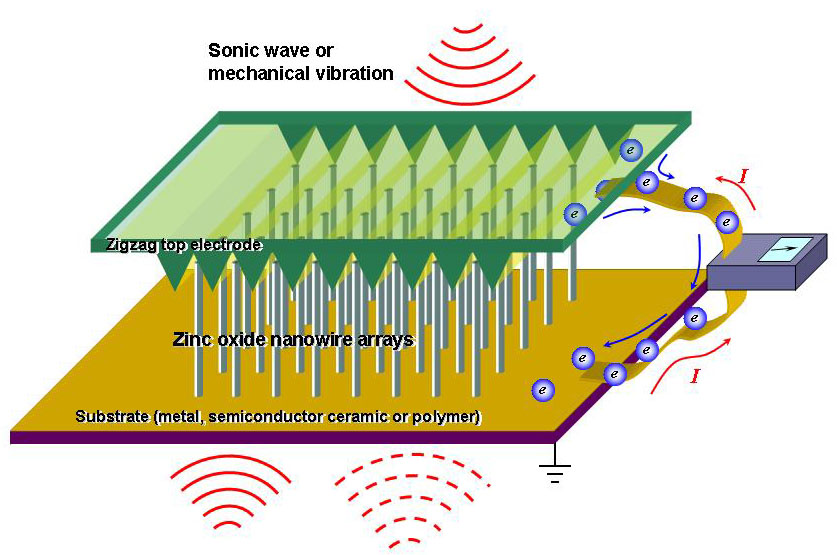 We have developed a nanowire nanogenerator that is driven by an ultrasonic wave to produce continuous direct-current output. The nanogenerator was fabricated with vertically aligned zinc oxide nanowire arrays that were placed beneath a zigzag metal electrode with a small gap. The wave drives the electrode up and down to bend and/or vibrate the nanowires. A piezoelectricsemiconducting coupling process converts mechanical energy into electricity. The zigzag electrode acts as an array of parallel integrated metal tips that simultaneously and continuously create, collect, and output electricity from all of the nanowires. The approach presents an adaptable, mobile, and cost-effective technology for harvesting energy from the environment, and it offers a potential solution for powering nanodevices and nanosystems. We have developed a nanowire nanogenerator that is driven by an ultrasonic wave to produce continuous direct-current output. The nanogenerator was fabricated with vertically aligned zinc oxide nanowire arrays that were placed beneath a zigzag metal electrode with a small gap. The wave drives the electrode up and down to bend and/or vibrate the nanowires. A piezoelectricsemiconducting coupling process converts mechanical energy into electricity. The zigzag electrode acts as an array of parallel integrated metal tips that simultaneously and continuously create, collect, and output electricity from all of the nanowires. The approach presents an adaptable, mobile, and cost-effective technology for harvesting energy from the environment, and it offers a potential solution for powering nanodevices and nanosystems.
|
|
Converting Ceria Polyhedral Nanoparticles into Single-Crystal Nanospheres
X. Feng, D.C. Sayle, Z.L. Wang, M.S. Paras, B. Santora, A.C. Sutorik, T.X.T. Sayle, Y. Yang, Y. Ding, X.D. Wang, Y.S. Her Science, 312 (2006) 1504-1508
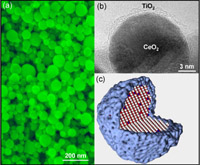 Ceria nanoparticles are one of the key abrasive materials for chemical-mechanical planarization of advanced integrated circuits. However, ceria nanoparticles synthesized by existing techniques are irregularly faceted, and they scratch the silicon wafers and increase defect concentrations. We developed an approach for large-scale synthesis of single-crystal ceria nanospheres that can reduce the polishing defects by 80% and increase the silica removal rate by 50%, facilitating precise and reliable mass-manufacturing of chips for nanoelectronics. We doped the ceria system with titanium, using flame temperatures that facilitate crystallization of the ceria yet retain the titania in a molten state. In conjunction with molecular dynamics simulation, we show that under these conditions, the inner ceria core evolves in a single-crystal spherical shape without faceting, because throughout the crystallization it is completely encapsulated by a molten 1- to 2-nanometer shell of titania that, in liquid state, minimizes the surface energy. The principle demonstrated here could be applied to other oxide systems. Ceria nanoparticles are one of the key abrasive materials for chemical-mechanical planarization of advanced integrated circuits. However, ceria nanoparticles synthesized by existing techniques are irregularly faceted, and they scratch the silicon wafers and increase defect concentrations. We developed an approach for large-scale synthesis of single-crystal ceria nanospheres that can reduce the polishing defects by 80% and increase the silica removal rate by 50%, facilitating precise and reliable mass-manufacturing of chips for nanoelectronics. We doped the ceria system with titanium, using flame temperatures that facilitate crystallization of the ceria yet retain the titania in a molten state. In conjunction with molecular dynamics simulation, we show that under these conditions, the inner ceria core evolves in a single-crystal spherical shape without faceting, because throughout the crystallization it is completely encapsulated by a molten 1- to 2-nanometer shell of titania that, in liquid state, minimizes the surface energy. The principle demonstrated here could be applied to other oxide systems.
|
|
Piezoelectric Nanogenerators Based on Zinc Oxide Nanowire Arrays
Z.L. Wang and J.H. Song Science, 14 April 2006: 242-246
 We have converted nanoscale mechanical energy into electrical energy by means of piezoelectric zinc oxide nanowire (NW) arrays. The aligned NWs are deflected with a conductive atomic force microscope tip in contact mode. The coupling of piezoelectric and semiconducting properties in zinc oxide creates a strain field and charge separation across the NW as a result of its bending. The rectifying characteristic of the Schottky barrier formed between the metal tip and the NW leads to electrical current generation. The efficiency of the NW-based piezoelectric power generator is estimated to be 17 to 30%. This approach has the potential of converting mechanical, vibrational, and/or hydraulic energy into electricity for powering nanodevices. We have converted nanoscale mechanical energy into electrical energy by means of piezoelectric zinc oxide nanowire (NW) arrays. The aligned NWs are deflected with a conductive atomic force microscope tip in contact mode. The coupling of piezoelectric and semiconducting properties in zinc oxide creates a strain field and charge separation across the NW as a result of its bending. The rectifying characteristic of the Schottky barrier formed between the metal tip and the NW leads to electrical current generation. The efficiency of the NW-based piezoelectric power generator is estimated to be 17 to 30%. This approach has the potential of converting mechanical, vibrational, and/or hydraulic energy into electricity for powering nanodevices.
|
|
Conversion of Zinc Oxide Nanobelts into Superlattice-Structured Nanohelices
P.X. Gao, Y. Ding, W. Mai, W.L. Hughes, C.S. Lao, Z.L. Wang Science, 309 (2005) 1700-1704.
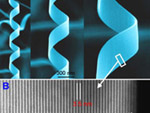 A previously unknown rigid helical structure of zinc oxide consisting of a superlattice-structured nanobelt was formed spontaneously in a vapor-solid growth process. Starting from a single-crystal stiff nanoribbon dominated by the c-plane polar surfaces, an abrupt structural transformation into the superlatticestructured nanobelt led to the formation of a uniform nanohelix due to a rigid lattice rotation or twisting. The nanohelix was made of two types of alternating and periodically distributed long crystal stripes, which were oriented with their c axes perpendicular to each other. The nanohelix terminated by transforming into a single-crystal nanobelt dominated by nonpolar (011¯0) surfaces. The nanohelix could be manipulated, and its elastic properties were measured, which suggests possible uses in electromechanically coupled sensors, transducers, and resonators. A previously unknown rigid helical structure of zinc oxide consisting of a superlattice-structured nanobelt was formed spontaneously in a vapor-solid growth process. Starting from a single-crystal stiff nanoribbon dominated by the c-plane polar surfaces, an abrupt structural transformation into the superlatticestructured nanobelt led to the formation of a uniform nanohelix due to a rigid lattice rotation or twisting. The nanohelix was made of two types of alternating and periodically distributed long crystal stripes, which were oriented with their c axes perpendicular to each other. The nanohelix terminated by transforming into a single-crystal nanobelt dominated by nonpolar (011¯0) surfaces. The nanohelix could be manipulated, and its elastic properties were measured, which suggests possible uses in electromechanically coupled sensors, transducers, and resonators.
|
|
Single-crystal nanorings formed by epitaxial self-coiling of polar-nanobelts
X.Y. Kong, Y. Ding, R.S. Yang, Z.L. Wang, Science, 303 (2004) 1348-1351
 Freestanding single-crystal complete nanorings of zinc oxide were formed via a spontaneous self-coiling process during the growth of polar nanobelts. The nanoring appeared to be initiated by circular folding of a nanobelt, caused by longrange electrostatic interaction. Coaxial and uniradial loop-by-loop winding of the nanobelt formed a complete ring. Short-range chemical bonding among the loops resulted in a single-crystal structure. The self-coiling is likely to be driven by minimizing the energy contributed by polar charges, surface area, and elastic deformation. Zinc oxide nanorings formed by self-coiling of nanobelts may be useful for investigating polar surface–induced growth processes, fundamental physics phenomena, and nanoscale devices. Freestanding single-crystal complete nanorings of zinc oxide were formed via a spontaneous self-coiling process during the growth of polar nanobelts. The nanoring appeared to be initiated by circular folding of a nanobelt, caused by longrange electrostatic interaction. Coaxial and uniradial loop-by-loop winding of the nanobelt formed a complete ring. Short-range chemical bonding among the loops resulted in a single-crystal structure. The self-coiling is likely to be driven by minimizing the energy contributed by polar charges, surface area, and elastic deformation. Zinc oxide nanorings formed by self-coiling of nanobelts may be useful for investigating polar surface–induced growth processes, fundamental physics phenomena, and nanoscale devices.
|
|
Exchange-coupled nanocomposite magnets by nanoparticle self-assembly
Hao Zeng, Jing Li, J. P. Liu, Zhong L. Wang and Shouheng Sun, Nature, 420 (2002) 395-398.
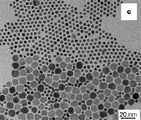 Exchange-spring magnets are nanocomposites that are composed of magnetically hard and soft phases that interact by magnetic exchange coupling. Such systems are promising for advanced permanent magnetic applications, as they have a large energy product—the combination of permanent magnet field and magnetization—compared to traditional, single-phase materials. Conventional techniques, including melt-spinning, mechanical milling and sputtering, have been explored to prepare exchange-spring magnets. However, the requirement that both the hard and soft phases are controlled at the nanometre scale, to ensure efficient exchange coupling, has posed significant preparation challenges. Here we report the fabrication of exchange-coupled nanocomposites using nanoparticle self-assembly. In this approach, both FePt and Fe3O4 particles are incorporated as nanometre-scale building blocks into binary assemblies. Subsequent annealing converts the assembly into FePt–Fe3Pt nanocomposites, where FePt is a magnetically hard phase and Fe3Pt a soft phase. An optimum exchange coupling, and therefore an optimum energy product, can be obtained by independently tuning the size and composition of the individual building blocks. We have produced exchange-coupled isotropic FePt–Fe3Pt nanocomposites with an energy product of 20.1 MG Oe, which exceeds the theoretical limit of 13 MG Oe for non-exchange-coupled isotropic FePt by over 50 per cent. Exchange-spring magnets are nanocomposites that are composed of magnetically hard and soft phases that interact by magnetic exchange coupling. Such systems are promising for advanced permanent magnetic applications, as they have a large energy product—the combination of permanent magnet field and magnetization—compared to traditional, single-phase materials. Conventional techniques, including melt-spinning, mechanical milling and sputtering, have been explored to prepare exchange-spring magnets. However, the requirement that both the hard and soft phases are controlled at the nanometre scale, to ensure efficient exchange coupling, has posed significant preparation challenges. Here we report the fabrication of exchange-coupled nanocomposites using nanoparticle self-assembly. In this approach, both FePt and Fe3O4 particles are incorporated as nanometre-scale building blocks into binary assemblies. Subsequent annealing converts the assembly into FePt–Fe3Pt nanocomposites, where FePt is a magnetically hard phase and Fe3Pt a soft phase. An optimum exchange coupling, and therefore an optimum energy product, can be obtained by independently tuning the size and composition of the individual building blocks. We have produced exchange-coupled isotropic FePt–Fe3Pt nanocomposites with an energy product of 20.1 MG Oe, which exceeds the theoretical limit of 13 MG Oe for non-exchange-coupled isotropic FePt by over 50 per cent.
|
|
Nanobelts of semiconducting oxides
Z.W. Pan, Z.R. Dai and Z.L. Wang, Science, 291 (2001) 1947-1949.
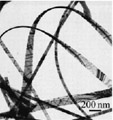 Ultralong beltlike (or ribbonlike) nanostructures (so-called nanobelts) were successfully synthesized for semiconducting oxides of zinc, tin, indium, cadmium, and gallium by simply evaporating the desired commercial metal oxide powders at high temperatures. The as-synthesized oxide nanobelts are pure, structurally uniform, and single crystalline, and most of them are free from defects and dislocations. They have a rectanglelike cross section with typical widths of 30 to 300 nanometers, width-to-thickness ratios of 5 to 10, and lengths of up to a few millimeters. The beltlike morphology appears to be a distinctive and common structural characteristic for the family of semiconducting oxides with cations of different valence states and materials of distinct crystallographic structures. The nanobelts could be an ideal system for fully understanding dimensionally confined transport phenomena in functional oxides and building functional devices along individual nanobelts. Ultralong beltlike (or ribbonlike) nanostructures (so-called nanobelts) were successfully synthesized for semiconducting oxides of zinc, tin, indium, cadmium, and gallium by simply evaporating the desired commercial metal oxide powders at high temperatures. The as-synthesized oxide nanobelts are pure, structurally uniform, and single crystalline, and most of them are free from defects and dislocations. They have a rectanglelike cross section with typical widths of 30 to 300 nanometers, width-to-thickness ratios of 5 to 10, and lengths of up to a few millimeters. The beltlike morphology appears to be a distinctive and common structural characteristic for the family of semiconducting oxides with cations of different valence states and materials of distinct crystallographic structures. The nanobelts could be an ideal system for fully understanding dimensionally confined transport phenomena in functional oxides and building functional devices along individual nanobelts.
|
|
Electrostatic Deflections and Electromechanical Resonances of Carbon Nanotubes
P. Poncharal, Z.L. Wang, D. Ugarte and W.A. De Heer, Science, 283 (1999) 1513-1516
 Static and dynamic mechanical deflections were electrically induced in cantilevered, multiwalled carbon nanotubes in a transmission electron microscope. The nanotubes were resonantly excited at the fundamental frequency and higher harmonics as revealed by their deflected contours, which correspond closely to those determined for cantilevered elastic beams. The elastic bending modulus as a function of diameter was found to decrease sharply (from about 1 to 0.1 terapascals) with increasing diameter (from 8 to 40 nanometers), which indicates a crossover from a uniform elastic mode to an elastic mode that involves wavelike distortions in the nanotube. The quality factors of the resonances are on the order of 500. The methods developed here have been applied to a nanobalance for nanoscopic particles and also to a Kelvin probe based on nanotubes. Static and dynamic mechanical deflections were electrically induced in cantilevered, multiwalled carbon nanotubes in a transmission electron microscope. The nanotubes were resonantly excited at the fundamental frequency and higher harmonics as revealed by their deflected contours, which correspond closely to those determined for cantilevered elastic beams. The elastic bending modulus as a function of diameter was found to decrease sharply (from about 1 to 0.1 terapascals) with increasing diameter (from 8 to 40 nanometers), which indicates a crossover from a uniform elastic mode to an elastic mode that involves wavelike distortions in the nanotube. The quality factors of the resonances are on the order of 500. The methods developed here have been applied to a nanobalance for nanoscopic particles and also to a Kelvin probe based on nanotubes.
|
|
Carbon Nanotube Quantum Resistors
S. Frank, P. Poncharal, Z.L. Wang, and W.A. De Heer, Science, 280 (1998) 1744-1746
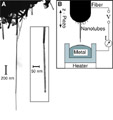 The conductance of multiwalled carbon nanotubes (MWNTs) was found to be quantized. The experimental method involved measuring the conductance of nanotubes by replacing the tip of a scanning probe microscope with a nanotube fiber, which could be lowered into a liquid metal to establish a gentle electrical contact with a nanotube at the tip of the fiber. The conductance of arc-produced MWNTs is one unit of the conductance quantum G0 = 2e2/h = 12.9 (kilohms)-1. The nanotubes conduct current ballistically and do not dissipate heat. The nanotubes, which are typically 15 nanometers wide and 4 micrometers long, are several orders of magnitude greater in size and stability than other typical room-temperature quantum conductors. Extremely high stable current densities, J > 107 amperes per square centimeter, have been attained. The conductance of multiwalled carbon nanotubes (MWNTs) was found to be quantized. The experimental method involved measuring the conductance of nanotubes by replacing the tip of a scanning probe microscope with a nanotube fiber, which could be lowered into a liquid metal to establish a gentle electrical contact with a nanotube at the tip of the fiber. The conductance of arc-produced MWNTs is one unit of the conductance quantum G0 = 2e2/h = 12.9 (kilohms)-1. The nanotubes conduct current ballistically and do not dissipate heat. The nanotubes, which are typically 15 nanometers wide and 4 micrometers long, are several orders of magnitude greater in size and stability than other typical room-temperature quantum conductors. Extremely high stable current densities, J > 107 amperes per square centimeter, have been attained.
|
|
Shape-Controlled Synthesis of Colloidal Platinum Nanoparticles
T.S. Ahmadi, Z.L. Wang, T.C. Green, A. Henglein and M.A. El-Sayed, Science, 272 (1996) 1924-1926
The shapes and sizes of platinum nanoparticles were controlled by changes in the ratio of the concentration of the capping polymer material to the concentration of the platinum cations used in the reductive synthesis of colloidal particles in solution at room temperature. Tetrahedral, cubic, irregular-prismatic, icosahedral, and cubo-octahedral particle shapes were observed, whose distribution was dependent on the concentration ratio of the capping polymer material to the platinum cation. Controlling the shape of platinum nanoparticles is potentially important in the field of catalysis. |
|



 We have developed a nanowire nanogenerator that is driven by an ultrasonic wave to produce continuous direct-current output. The nanogenerator was fabricated with vertically aligned zinc oxide nanowire arrays that were placed beneath a zigzag metal electrode with a small gap. The wave drives the electrode up and down to bend and/or vibrate the nanowires. A piezoelectricsemiconducting coupling process converts mechanical energy into electricity. The zigzag electrode acts as an array of parallel integrated metal tips that simultaneously and continuously create, collect, and output electricity from all of the nanowires. The approach presents an adaptable, mobile, and cost-effective technology for harvesting energy from the environment, and it offers a potential solution for powering nanodevices and nanosystems.
We have developed a nanowire nanogenerator that is driven by an ultrasonic wave to produce continuous direct-current output. The nanogenerator was fabricated with vertically aligned zinc oxide nanowire arrays that were placed beneath a zigzag metal electrode with a small gap. The wave drives the electrode up and down to bend and/or vibrate the nanowires. A piezoelectricsemiconducting coupling process converts mechanical energy into electricity. The zigzag electrode acts as an array of parallel integrated metal tips that simultaneously and continuously create, collect, and output electricity from all of the nanowires. The approach presents an adaptable, mobile, and cost-effective technology for harvesting energy from the environment, and it offers a potential solution for powering nanodevices and nanosystems. Ceria nanoparticles are one of the key abrasive materials for chemical-mechanical planarization of advanced integrated circuits. However, ceria nanoparticles synthesized by existing techniques are irregularly faceted, and they scratch the silicon wafers and increase defect concentrations. We developed an approach for large-scale synthesis of single-crystal ceria nanospheres that can reduce the polishing defects by 80% and increase the silica removal rate by 50%, facilitating precise and reliable mass-manufacturing of chips for nanoelectronics. We doped the ceria system with titanium, using flame temperatures that facilitate crystallization of the ceria yet retain the titania in a molten state. In conjunction with molecular dynamics simulation, we show that under these conditions, the inner ceria core evolves in a single-crystal spherical shape without faceting, because throughout the crystallization it is completely encapsulated by a molten 1- to 2-nanometer shell of titania that, in liquid state, minimizes the surface energy. The principle demonstrated here could be applied to other oxide systems.
Ceria nanoparticles are one of the key abrasive materials for chemical-mechanical planarization of advanced integrated circuits. However, ceria nanoparticles synthesized by existing techniques are irregularly faceted, and they scratch the silicon wafers and increase defect concentrations. We developed an approach for large-scale synthesis of single-crystal ceria nanospheres that can reduce the polishing defects by 80% and increase the silica removal rate by 50%, facilitating precise and reliable mass-manufacturing of chips for nanoelectronics. We doped the ceria system with titanium, using flame temperatures that facilitate crystallization of the ceria yet retain the titania in a molten state. In conjunction with molecular dynamics simulation, we show that under these conditions, the inner ceria core evolves in a single-crystal spherical shape without faceting, because throughout the crystallization it is completely encapsulated by a molten 1- to 2-nanometer shell of titania that, in liquid state, minimizes the surface energy. The principle demonstrated here could be applied to other oxide systems. We have converted nanoscale mechanical energy into electrical energy by means of piezoelectric zinc oxide nanowire (NW) arrays. The aligned NWs are deflected with a conductive atomic force microscope tip in contact mode. The coupling of piezoelectric and semiconducting properties in zinc oxide creates a strain field and charge separation across the NW as a result of its bending. The rectifying characteristic of the Schottky barrier formed between the metal tip and the NW leads to electrical current generation. The efficiency of the NW-based piezoelectric power generator is estimated to be 17 to 30%. This approach has the potential of converting mechanical, vibrational, and/or hydraulic energy into electricity for powering nanodevices.
We have converted nanoscale mechanical energy into electrical energy by means of piezoelectric zinc oxide nanowire (NW) arrays. The aligned NWs are deflected with a conductive atomic force microscope tip in contact mode. The coupling of piezoelectric and semiconducting properties in zinc oxide creates a strain field and charge separation across the NW as a result of its bending. The rectifying characteristic of the Schottky barrier formed between the metal tip and the NW leads to electrical current generation. The efficiency of the NW-based piezoelectric power generator is estimated to be 17 to 30%. This approach has the potential of converting mechanical, vibrational, and/or hydraulic energy into electricity for powering nanodevices. A previously unknown rigid helical structure of zinc oxide consisting of a superlattice-structured nanobelt was formed spontaneously in a vapor-solid growth process. Starting from a single-crystal stiff nanoribbon dominated by the c-plane polar surfaces, an abrupt structural transformation into the superlatticestructured nanobelt led to the formation of a uniform nanohelix due to a rigid lattice rotation or twisting. The nanohelix was made of two types of alternating and periodically distributed long crystal stripes, which were oriented with their c axes perpendicular to each other. The nanohelix terminated by transforming into a single-crystal nanobelt dominated by nonpolar (011¯0) surfaces. The nanohelix could be manipulated, and its elastic properties were measured, which suggests possible uses in electromechanically coupled sensors, transducers, and resonators.
A previously unknown rigid helical structure of zinc oxide consisting of a superlattice-structured nanobelt was formed spontaneously in a vapor-solid growth process. Starting from a single-crystal stiff nanoribbon dominated by the c-plane polar surfaces, an abrupt structural transformation into the superlatticestructured nanobelt led to the formation of a uniform nanohelix due to a rigid lattice rotation or twisting. The nanohelix was made of two types of alternating and periodically distributed long crystal stripes, which were oriented with their c axes perpendicular to each other. The nanohelix terminated by transforming into a single-crystal nanobelt dominated by nonpolar (011¯0) surfaces. The nanohelix could be manipulated, and its elastic properties were measured, which suggests possible uses in electromechanically coupled sensors, transducers, and resonators. Freestanding single-crystal complete nanorings of zinc oxide were formed via a spontaneous self-coiling process during the growth of polar nanobelts. The nanoring appeared to be initiated by circular folding of a nanobelt, caused by longrange electrostatic interaction. Coaxial and uniradial loop-by-loop winding of the nanobelt formed a complete ring. Short-range chemical bonding among the loops resulted in a single-crystal structure. The self-coiling is likely to be driven by minimizing the energy contributed by polar charges, surface area, and elastic deformation. Zinc oxide nanorings formed by self-coiling of nanobelts may be useful for investigating polar surface–induced growth processes, fundamental physics phenomena, and nanoscale devices.
Freestanding single-crystal complete nanorings of zinc oxide were formed via a spontaneous self-coiling process during the growth of polar nanobelts. The nanoring appeared to be initiated by circular folding of a nanobelt, caused by longrange electrostatic interaction. Coaxial and uniradial loop-by-loop winding of the nanobelt formed a complete ring. Short-range chemical bonding among the loops resulted in a single-crystal structure. The self-coiling is likely to be driven by minimizing the energy contributed by polar charges, surface area, and elastic deformation. Zinc oxide nanorings formed by self-coiling of nanobelts may be useful for investigating polar surface–induced growth processes, fundamental physics phenomena, and nanoscale devices. Exchange-spring magnets are nanocomposites that are composed of magnetically hard and soft phases that interact by magnetic exchange coupling. Such systems are promising for advanced permanent magnetic applications, as they have a large energy product—the combination of permanent magnet field and magnetization—compared to traditional, single-phase materials. Conventional techniques, including melt-spinning, mechanical milling and sputtering, have been explored to prepare exchange-spring magnets. However, the requirement that both the hard and soft phases are controlled at the nanometre scale, to ensure efficient exchange coupling, has posed significant preparation challenges. Here we report the fabrication of exchange-coupled nanocomposites using nanoparticle self-assembly. In this approach, both FePt and Fe3O4 particles are incorporated as nanometre-scale building blocks into binary assemblies. Subsequent annealing converts the assembly into FePt–Fe3Pt nanocomposites, where FePt is a magnetically hard phase and Fe3Pt a soft phase. An optimum exchange coupling, and therefore an optimum energy product, can be obtained by independently tuning the size and composition of the individual building blocks. We have produced exchange-coupled isotropic FePt–Fe3Pt nanocomposites with an energy product of 20.1 MG Oe, which exceeds the theoretical limit of 13 MG Oe for non-exchange-coupled isotropic FePt by over 50 per cent.
Exchange-spring magnets are nanocomposites that are composed of magnetically hard and soft phases that interact by magnetic exchange coupling. Such systems are promising for advanced permanent magnetic applications, as they have a large energy product—the combination of permanent magnet field and magnetization—compared to traditional, single-phase materials. Conventional techniques, including melt-spinning, mechanical milling and sputtering, have been explored to prepare exchange-spring magnets. However, the requirement that both the hard and soft phases are controlled at the nanometre scale, to ensure efficient exchange coupling, has posed significant preparation challenges. Here we report the fabrication of exchange-coupled nanocomposites using nanoparticle self-assembly. In this approach, both FePt and Fe3O4 particles are incorporated as nanometre-scale building blocks into binary assemblies. Subsequent annealing converts the assembly into FePt–Fe3Pt nanocomposites, where FePt is a magnetically hard phase and Fe3Pt a soft phase. An optimum exchange coupling, and therefore an optimum energy product, can be obtained by independently tuning the size and composition of the individual building blocks. We have produced exchange-coupled isotropic FePt–Fe3Pt nanocomposites with an energy product of 20.1 MG Oe, which exceeds the theoretical limit of 13 MG Oe for non-exchange-coupled isotropic FePt by over 50 per cent. Ultralong beltlike (or ribbonlike) nanostructures (so-called nanobelts) were successfully synthesized for semiconducting oxides of zinc, tin, indium, cadmium, and gallium by simply evaporating the desired commercial metal oxide powders at high temperatures. The as-synthesized oxide nanobelts are pure, structurally uniform, and single crystalline, and most of them are free from defects and dislocations. They have a rectanglelike cross section with typical widths of 30 to 300 nanometers, width-to-thickness ratios of 5 to 10, and lengths of up to a few millimeters. The beltlike morphology appears to be a distinctive and common structural characteristic for the family of semiconducting oxides with cations of different valence states and materials of distinct crystallographic structures. The nanobelts could be an ideal system for fully understanding dimensionally confined transport phenomena in functional oxides and building functional devices along individual nanobelts.
Ultralong beltlike (or ribbonlike) nanostructures (so-called nanobelts) were successfully synthesized for semiconducting oxides of zinc, tin, indium, cadmium, and gallium by simply evaporating the desired commercial metal oxide powders at high temperatures. The as-synthesized oxide nanobelts are pure, structurally uniform, and single crystalline, and most of them are free from defects and dislocations. They have a rectanglelike cross section with typical widths of 30 to 300 nanometers, width-to-thickness ratios of 5 to 10, and lengths of up to a few millimeters. The beltlike morphology appears to be a distinctive and common structural characteristic for the family of semiconducting oxides with cations of different valence states and materials of distinct crystallographic structures. The nanobelts could be an ideal system for fully understanding dimensionally confined transport phenomena in functional oxides and building functional devices along individual nanobelts. Static and dynamic mechanical deflections were electrically induced in cantilevered, multiwalled carbon nanotubes in a transmission electron microscope. The nanotubes were resonantly excited at the fundamental frequency and higher harmonics as revealed by their deflected contours, which correspond closely to those determined for cantilevered elastic beams. The elastic bending modulus as a function of diameter was found to decrease sharply (from about 1 to 0.1 terapascals) with increasing diameter (from 8 to 40 nanometers), which indicates a crossover from a uniform elastic mode to an elastic mode that involves wavelike distortions in the nanotube. The quality factors of the resonances are on the order of 500. The methods developed here have been applied to a nanobalance for nanoscopic particles and also to a Kelvin probe based on nanotubes.
Static and dynamic mechanical deflections were electrically induced in cantilevered, multiwalled carbon nanotubes in a transmission electron microscope. The nanotubes were resonantly excited at the fundamental frequency and higher harmonics as revealed by their deflected contours, which correspond closely to those determined for cantilevered elastic beams. The elastic bending modulus as a function of diameter was found to decrease sharply (from about 1 to 0.1 terapascals) with increasing diameter (from 8 to 40 nanometers), which indicates a crossover from a uniform elastic mode to an elastic mode that involves wavelike distortions in the nanotube. The quality factors of the resonances are on the order of 500. The methods developed here have been applied to a nanobalance for nanoscopic particles and also to a Kelvin probe based on nanotubes. The conductance of multiwalled carbon nanotubes (MWNTs) was found to be quantized. The experimental method involved measuring the conductance of nanotubes by replacing the tip of a scanning probe microscope with a nanotube fiber, which could be lowered into a liquid metal to establish a gentle electrical contact with a nanotube at the tip of the fiber. The conductance of arc-produced MWNTs is one unit of the conductance quantum G0 = 2e2/h = 12.9 (kilohms)-1. The nanotubes conduct current ballistically and do not dissipate heat. The nanotubes, which are typically 15 nanometers wide and 4 micrometers long, are several orders of magnitude greater in size and stability than other typical room-temperature quantum conductors. Extremely high stable current densities, J > 107 amperes per square centimeter, have been attained.
The conductance of multiwalled carbon nanotubes (MWNTs) was found to be quantized. The experimental method involved measuring the conductance of nanotubes by replacing the tip of a scanning probe microscope with a nanotube fiber, which could be lowered into a liquid metal to establish a gentle electrical contact with a nanotube at the tip of the fiber. The conductance of arc-produced MWNTs is one unit of the conductance quantum G0 = 2e2/h = 12.9 (kilohms)-1. The nanotubes conduct current ballistically and do not dissipate heat. The nanotubes, which are typically 15 nanometers wide and 4 micrometers long, are several orders of magnitude greater in size and stability than other typical room-temperature quantum conductors. Extremely high stable current densities, J > 107 amperes per square centimeter, have been attained.